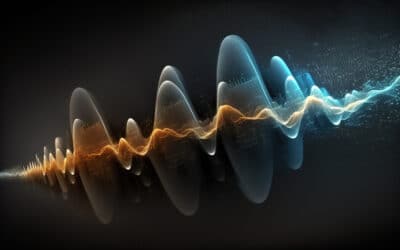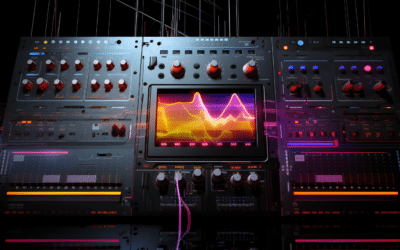Tips and Tricks on How to Make Lofi Music
If you’ve stumbled on a playlist titled “study music,” “beats to relax to,” or “chill beats,” you’ve heard lofi music. OK great… but what exactly is it? And how do you make lofi music? Read on for some background context, then dig into approaches to producing lofi tracks that will make listeners’ heads nod.
What is lofi music?
Lo fi is short for “low fidelity.” It’s more a production aesthetic than any specific genre. Lofi music can be created with do-it-yourself (DIY) methods available to any producer.
Producers first made lofi with 4 track recorders and early consumer recording gear. As tape heads wear down, they produce a tape hiss noise that limits high frequencies. It also adds saturation and warmth. Early digital samplers with lower bit depths produce a similar crunchy sound.
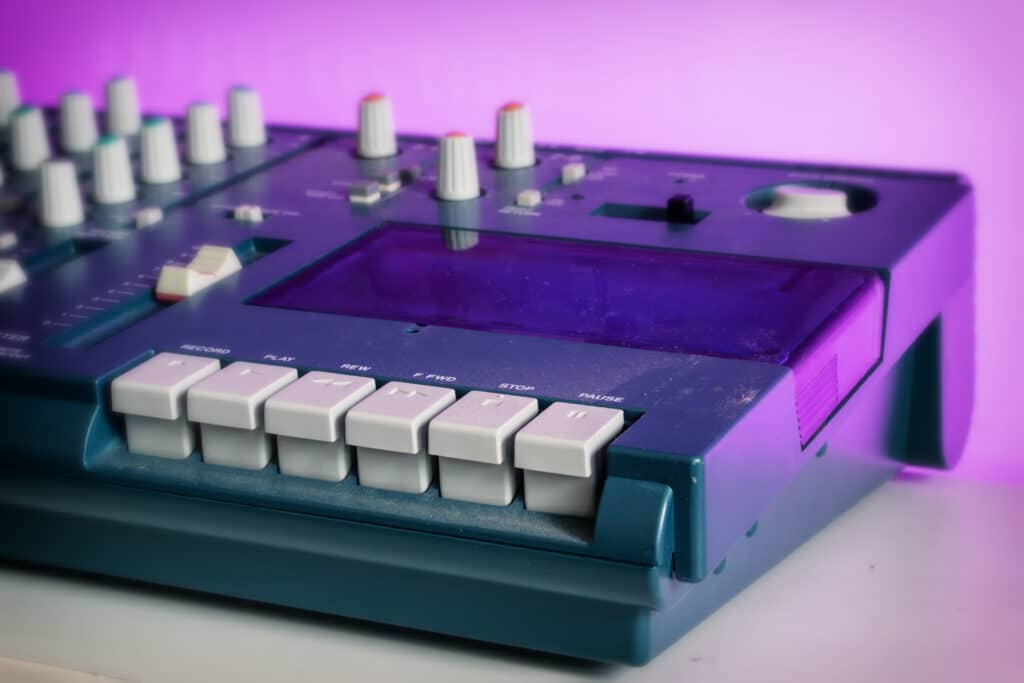
Today, lofi producers use these imperfections intentionally. Lofi hip hop producers Boards of Canada use worn out tape machines that sounded like warped VHS cassettes for a nostalgic vibe. If vintage gear isn’t your thing, plugins can do the trick.
Lofi usually features instrumentals that revolve around simpler chords and melodies. However, lofi uses looping extensively, and multiple loops can create more intricate structures. Lofi tracks have a chill vibe that can demand your attention but also flow seamlessly in the background. But don’t just take our word for it. Put on a lofi playlist and see what you think.
How did lofi music come to be?
The term “lofi” has been around since the dawn of professional recording. It came into more common use in the mid-80s. With the introduction of CDs and digital technology, some listeners and producers realized they preferred a warmer sound over digital’s harshness.
Around this time, radio commanded massive audiences, and independent stations helped popularize lofi. DJ William Berger at prominent station WFMU dedicated a slot on his weekly radio show to lofi tracks. Here’s an example of one of his shows. Indie musicians and record labels also embraced the style, using DIY techniques to make records on a budget.
Daniel Johnston was a lofi pioneer. His sincere songwriting style inspired Kurt Cobain to proudly wear a shirt displaying Johnston’s “Hi, How Are You” album cover at the VMAs. Beck is another good example, blending folk, hip hop, and alternative. His 1994 single “Loser,” made him a standard-bearer of ‘90s lofi.
Throughout the 2000s, lofi started to sound more like what you hear on playlists today. Artists like Nujabes, Boards of Canada, early Gorillaz, and many others blazed the trail. Mixing earworm melodies, nonchalant yet catchy grooves, and simple but effective beat patterns, their styles embraced the rawness of the artistic process.
How do you make lofi music?
So now for the good stuff: actually making lofi music. This section offers several approaches to point you in the right direction. Keep in mind that this is art, not science. These aren’t rules. They’re general guidelines.
The Secret Sauce
Making lofi music requires adding warmth and saturation to your production. Obviously you’ll start with a recording and arrangement tool. For most reading this, that will be Ableton, FL Studio, Logic, or any other digital audio workstation (DAW).
You can fast track a lofi sound with a plugin that adds the necessary grit. Check out this list from our friends at LANDR to find one that suits you. Another approach is adding a sample of noise, tape hiss, or vinyl crackle. Dialing in reverb, delay, and distortion throughout the track also goes a long way.
If you’re set on authenticity, you can find an old Tascam, MPC, or even analog tape. But note, you’ll still have to export the finished track into a digital format to publish and share it. And while using vintage gear may be rewarding, most listeners won’t hear the difference.
Vibe and Intention
As you start creating, think about your desired vibe and your track’s intention. Do you want to make something relaxed? Nostalgic and sentimental? Funky, groovy, and sensual? Maybe a little melancholy, detached, and resigned? Jazzy?
Don’t overthink it. Lofi music has a sense of effortlessness, and that starts with the creative process. If you’re not sure where to start, make a beat and see where that takes you.
The Beat
Let’s start with tempo. Lo fi tracks typically fall between 65 and 95 bpm, the range of the average heart rate. For time signature, lofi is in 4/4, like most popular music.
For the rhythm, start with a simple beat structure for a single bar. We’re going to create a few lofi drum patterns from scratch here, but if you’re already a pro, skip to the next section. Also feel free to just grab a loop or sample an existing beat and move on.
The kick drum serves as the beat’s backbone and holds down the groove. It usually comes in on the first and third beat. The snare provides the drum pattern’s other key component. Snares typically land on the second and fourth beat. It may seem obvious, but the vast majority of lo fi beats are variations on this. We’ll call this pattern 1.
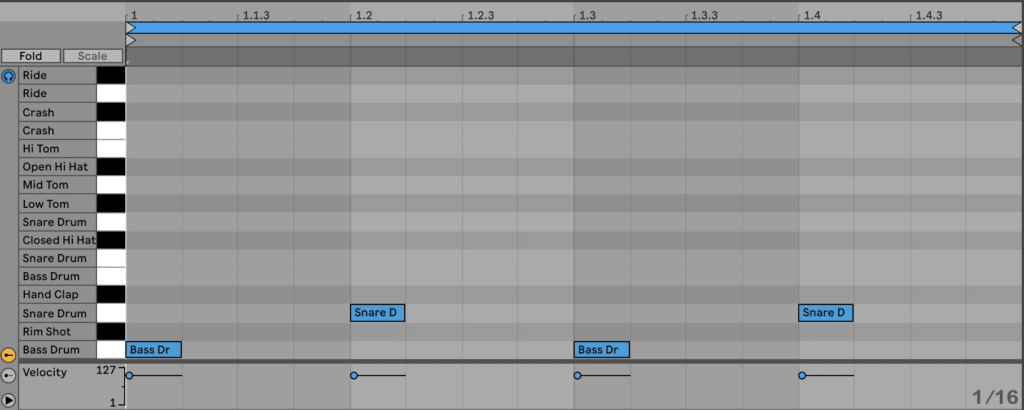
Let’s dig a little deeper with some boom bap lo fi hip hop beats. Many boom bap tracks just use pattern 1, but let’s switch it up. Add a syncopated kick before the third beat. Then put another kick on the “and” of the third beat (right between the kick and the snare in the second half of the bar). Now you’ve got pattern 2, another common beat.
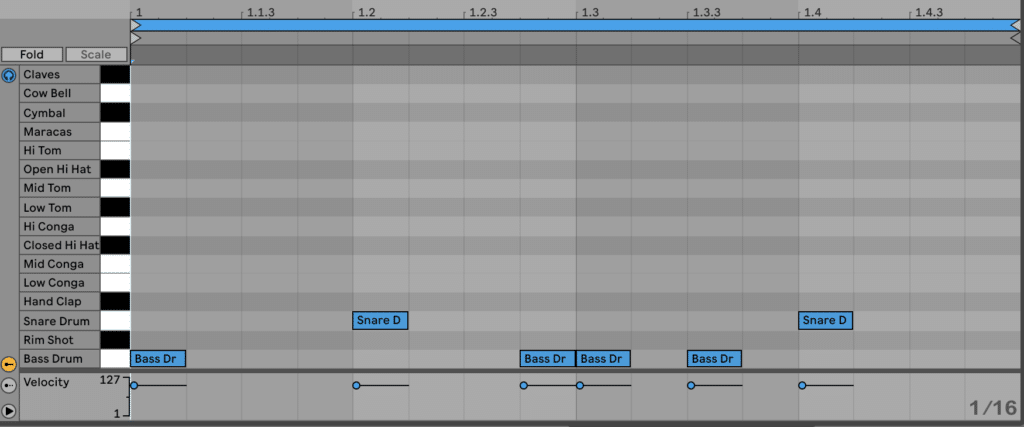
Now try adding another syncopated kick drum at the very end of the bar, right before it repeats (pattern 2A).
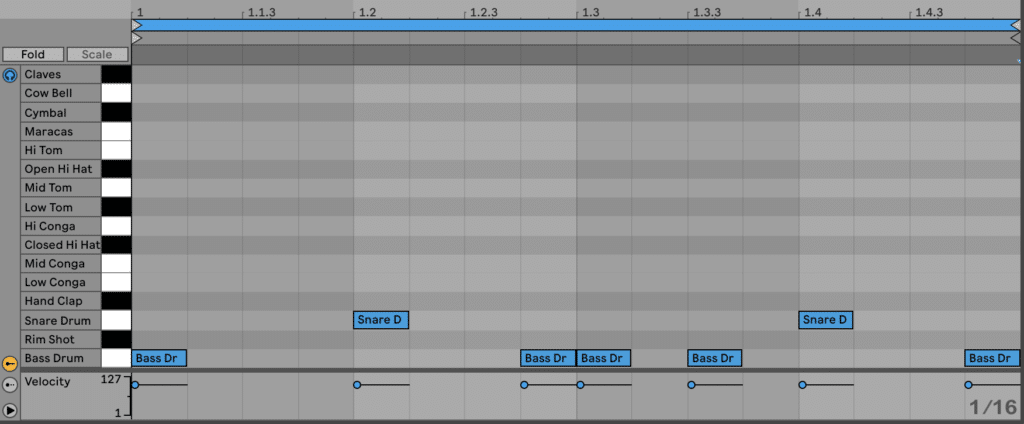
Or, remove the kick on the third beat (pattern 2B).
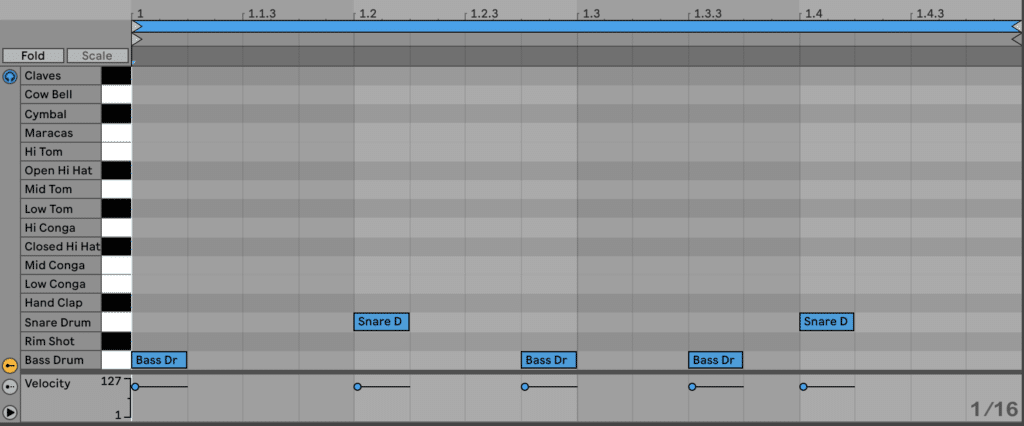
Experiment with similar variations to create a solid lo fi beat to hold down your track.
Drum Kit and Arrangement
Now for the actual kick and snare sounds. Lofi tracks typically use a snappy kick with healthy low-end. You won’t really hear booming 808 kicks. You can go with a synthesized electronic kick or an acoustic sound from a live kit. Just make sure it feels solid.
The snare opens up more options. A classic acoustic snare works, but you could also use a crunchy rim shot. Or a clap with some filtering, a short one-shot of a shaker, or a synthesized noise burst. You could sample a piece of paper ripping, a match lighting, or the stylus of a record player scuffing.
You’ve got hi hats, rides and crashes, toms, cowbells, tambourines, timbales, and more in your drum kit. And those are just traditional acoustic drum sounds. With sampling and editing techniques, you can create unique percussive sounds. The key for these other percussive elements is how they flow with the track. Rarely will lofi beats feature syncopated sixteenth note hi hats or dramatic tom fills.
Try creating 4 or 8 bar drum loops and seeing where things go. While you want a beat that makes the listener’s head nod, avoid making it too repetitive. Use short fills at the end of a loop. Add subtle variations to your main kick-snare pattern every few bars. For transitions, add phrases that complement parts in the new section. Just keep flow in mind. Jarring changes are even less desirable than overly repetitive beats.
Melodies, Riffs, Bass Lines, and Chords
This is where the possibilities really open up. Your chord progressions and phrasing help create a unique style. Only you will know what works for your music, but you’ll want to keep a few things in mind.
First, make sure these elements flow with the beat. You want your bass line and chord changes to reinforce the beat. Remember, many listeners play lofi music while they do work, chill with friends, or wind down after a long day. There’s no need for polyrhythms or abrupt chord changes that contrast with the beat too much.
As you’re creating the track, let your melodies, riffs, and bass lines breathe. Giving them space in the arrangement lets you add something that picks up where the previous phrase left off. Once you have one or two solid ideas, add countermelodies. Experimenting with loops is the way to get really interesting results. Try combining multiple phrases of different lengths–maybe a short riff in the midrange, a longer topline melody, and a medium-length bass line.
Instrumentation
So which instruments will play these earworm melodies and smooth chord progressions? There are plenty lofi sample packs to get you started. But if you’re paralyzed by all the choices, remember your vibe and intention. For jazz, try trumpet or saxophone phrases. For funk, an electric bass line, percussive guitar chords, or a clavinet riff could work.
Some sounds feel right at home in lo fi music. Pianos fit this description, and it doesn’t get much better than an acoustic grand piano. The tines of electric pianos also have a timbre well-suited to lofi. Plus, the tremolo and panning effects in electric pianos help gel with other tracks in the mix. Just plunk down a few chords, throw in neighboring tones, and you’ll start to find interesting melodies.
Mallets and Plucks for Playful Lofi Timbres
Mallet-based tones–marimbas, xylophones, vibraphones, and glockenspiels–can add captivating melodic components. They’re especially effective playing chord tones from a chord on another instrument. For a subtle touch, have them hit only once when the underlying chord starts. To create a more distinctive phrase, arpeggiate the notes of the underlying chord.
Mallets add a playful vibe since they conjure memories of childhood toys. Other pitched percussion instruments like steel pan, tongue drums, and hands drums have a similar effect.
Plucked sounds also work really well for melodies in lofi. In lofi electronic music, you’ll often hear synthesized plucks dialed in with saturation and reverb. If you’re looking for an acoustic pluck, harps are a great choice. They’re great for melody and can also add texture. This is especially true with glissandos: smooth, rapid successions of notes that play up and down the scale, pushing and pulling against the grid. Harp trills or bisbigliando work well to transition between parts. They can build anticipation between chord changes or new components of the beat.
These are just a few options. Just keep the creative flow going, try different things, and see how it sounds.
Dialing in Your Lofi Sound with CUBE
Many producers use sampling extensively to make lofi. You can take existing samples then process them, or write and produce with sampled instruments. If the latter approach suits you, CUBE can help unlock great lofi sounds.
The choices for lofi instrumentation are practically limitless, and so are CUBE’s possibilities. The Lunacy ecosystem contains 250 sampled instruments to cover every category imaginable. There are gorgeous strings, intimate keys, gritty analog synths, hybrid winds, futuristic pads, and more. With 1,000 presets to choose from, you can get quick results for any subgenre of lofi.
We mentioned how plucked and mallet-based sounds are perfect for lofi. We’ve got great news for lofi producers in the Lunacy ecosystem. Our latest expansion pack Pastels was inspired by artists and sound designers pushing lofi’s boundaries. We packed Pastels with some of our most exquisite sounds yet: harps with gorgeous articulations, playful kalimba plucks, and a range of mallet-based sounds including marimbas, vibraphones, and steelpan. Combining Pastels with CUBE’s synth pads, intimate keys, and other textures gives you a powerful lofi palette.
Now that you’ve got a strong understanding of lofi history and production techniques, producing blissful tracks that mesmerize listeners should be within reach.


